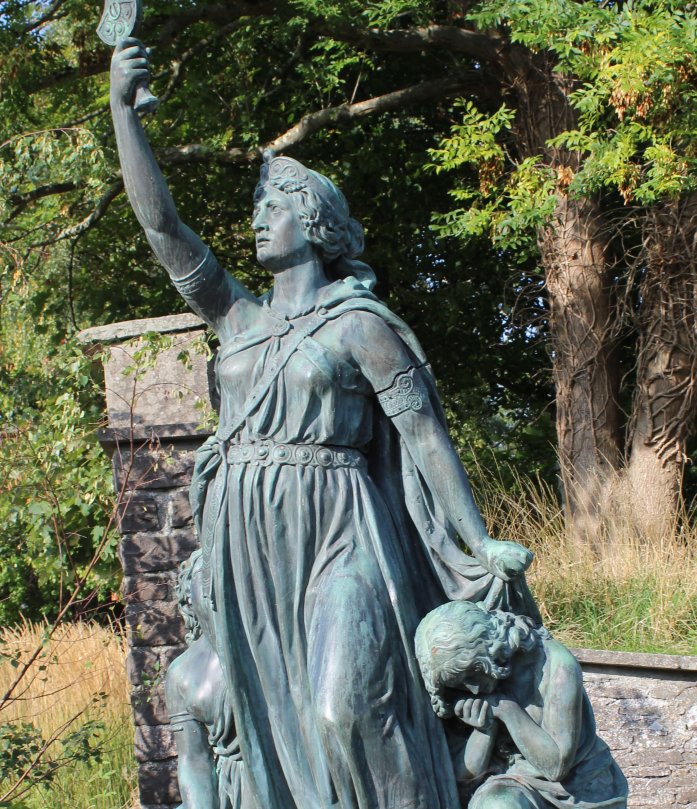The Iceni’s Queen Boudicca Who Revolted Against Roman Rule
A. Sutherland - AncientPages.com - The Iceni people were British Celts who occupied the area of modern Norfolk, Cambridgeshire, and northwest Suffolk. The tribe represented a significant power in eastern Britain during Claudius' conquest of Britain in 43 AD.
1855 Bronze statue of Boadicea (Boudica) and her daughters, at Captain's Walk in Brecon, Powys, Wales; by sculptor John Thomas. Image credit: 14GTR - CC BY-SA 4.0
In 47 AD, the Iceni rose in revolt after the Romans tried to enforce a law forbidding the carrying of weapons and increasing Roman influence on the tribe's affairs; their protest was put down, and Prasagustas was established as a client king.
Prasutagas decided that it would be wise to make his will assigning half of his personal property to the Roman emperor, and so it remained. However, when he died in 61 AD, the situation changed. The king's will was ignored, and the kingdom was annexed.
Boudica, Prasutagas's widow and queen of the Iceni tribe, was publicly flogged, her daughters raped, and the estates of the most prominent Iceni men were confiscated. In 61 AD, Boudicca raised the Iceni and the neighboring Trinivantes tribe in revolt against Roman rule.
She destroyed the invaders and chose Londinium as a critical target for her uprising. On her way to Londinium (modern London), Boudica and her army destroyed Camulodunum (modern Colchester), at that time a settlement for discharged Roman soldiers and the site of a temple to the former Emperor Claudius.
Boudicca's treatment of her enemies was brutal, and she must have given the Romans a terrific scare. One legion was so terrified that they refused to move against her. When the Iceni reached Londinium, they pillaged and burned down the city, killing all remaining inhabitants.
At first, the authorities could not prevent the Boudican revolt's advance. Upon hearing of the uprising, Governor Gaius Suetonius Paulinus hurried from the island of Anglesey off the northwest coast of Wales to Londinium to save the city. However, due to the lack of sufficient forces, he could not. He instead decided to sacrifice the single city of Londinium to save the entire province and gave the signal to abandon the city as soon as possible.
The inhabitants were allowed to accompany him. Only women, old or attached to the place, stayed in the city. An estimated 70,000–80,000 Romans and British were killed in the three towns by those led by Boudica. Suetonius, meanwhile, regrouped his soldiers and, despite being heavily outnumbered, defeated the Britons at the Battle of Watling Street.
The Roman historian Tacitus (56 AD – 117 AD) wrote about what Suetonius told his men before the fight:
"Ignore the racket made by these savages. They are not soldiers - they're not even properly equipped. There are more women than men in their ranks. We've beaten them before, and when they see our weapons and feel our spirit, they'll crack. Stick together. Throw the javelins, then push forward: knock them down with your shields and finish them off with your swords. Forget about plunder. Just win, and you'll have everything."
It was only with some difficulty that the Romans quelled the Iceni uprising. Londinium, the thriving port growing on the banks of the River Thames, was left in ruins. At first, Boudicca's fate was unknown, but later, people began to believe that she took her own life by taking poison rather than falling into her enemies' hands.
The Romans established a new capital in the Iceni lands at Caistor-by-Norwich. No record of the Iceni exists after this point, though legends suggest that many fled west into Wales and eventually settled in Ireland.
By the Middle Ages, Boudica was forgotten. She was not mentioned in "Historia Brittonum" by Venerable Bede, the earliest prose stories "Mabinogion' or Geoffrey of Monmouth's 'History of the Kings of Britain.'
There is a tendency to think of Boudicca as a great patriotic leader of the British, perhaps the first national heroine.
Many others do not consider her particularly appealing character.
Written by – A. Sutherland - AncientPages.com Senior Staff Writer
Updated on August 21, 2024
Copyright © AncientPages.com All rights reserved. This material may not be published, broadcast, rewritten or redistributed in whole or part without the express written permission of AncientPages.com
Expand for referencesReferences:
R. Hingley, Boudica: Iron Age Warrior Queen
Charles River Editors. Londinium
More From Ancient Pages
-
 Real Giant Kojomkul Who Became A Folk Hero In Kyrgyzstan
Featured Stories | Dec 2, 2020
Real Giant Kojomkul Who Became A Folk Hero In Kyrgyzstan
Featured Stories | Dec 2, 2020 -
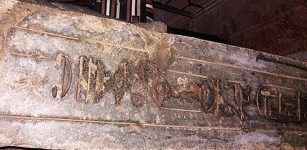 Black Granite Statue Of King Amenhotep III Accidentally Recovered
Archaeology | Jan 1, 2016
Black Granite Statue Of King Amenhotep III Accidentally Recovered
Archaeology | Jan 1, 2016 -
 Mother, Father, Child, Marriage And Divorce In Viking Society
Ancient History Facts | Apr 27, 2020
Mother, Father, Child, Marriage And Divorce In Viking Society
Ancient History Facts | Apr 27, 2020 -
 Fate Of The Woman Whose Mysterious Doppelgänger Ruined Her Life
Featured Stories | Mar 6, 2023
Fate Of The Woman Whose Mysterious Doppelgänger Ruined Her Life
Featured Stories | Mar 6, 2023 -
 Jiangshi – Terrifying Vicious Ancient Chinese Vampire In Disguise
Chinese Mythology | Jun 11, 2020
Jiangshi – Terrifying Vicious Ancient Chinese Vampire In Disguise
Chinese Mythology | Jun 11, 2020 -
 Ancient DNA’s Analysis Delivers Crucial Clues To Migratory Patterns During The First Millennium AD
DNA | Jan 2, 2025
Ancient DNA’s Analysis Delivers Crucial Clues To Migratory Patterns During The First Millennium AD
DNA | Jan 2, 2025 -
 Hundreds Of Rock Paintings Found In Tanzania By Polish Archaeologist
Archaeology | Jul 11, 2018
Hundreds Of Rock Paintings Found In Tanzania By Polish Archaeologist
Archaeology | Jul 11, 2018 -
 Can Peptide Droplets Explain The Emergence Of The First Living Organisms On Earth?
Archaeology | Oct 20, 2021
Can Peptide Droplets Explain The Emergence Of The First Living Organisms On Earth?
Archaeology | Oct 20, 2021 -
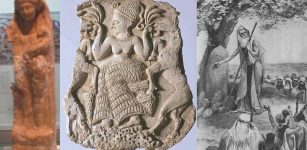 Lost And Forgotten Goddess Asherah – Queen Consort Of The Sumerian God Anu And Ugaritic God El
Biblical Mysteries | Apr 12, 2017
Lost And Forgotten Goddess Asherah – Queen Consort Of The Sumerian God Anu And Ugaritic God El
Biblical Mysteries | Apr 12, 2017 -
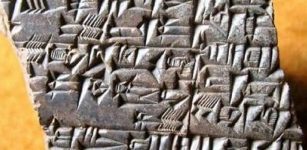 Sumerian Clay Brick With Inscription In Honor Of God Enki Returns To Iraq
Archaeology | May 5, 2015
Sumerian Clay Brick With Inscription In Honor Of God Enki Returns To Iraq
Archaeology | May 5, 2015 -
 The Opening Of Pandora’s Box May Have Been A Real Event
Myths & Legends | Jun 22, 2021
The Opening Of Pandora’s Box May Have Been A Real Event
Myths & Legends | Jun 22, 2021 -
 Evidence Scots And Irish Settled Iceland A Century Before The Vikings?
Featured Stories | Jan 7, 2023
Evidence Scots And Irish Settled Iceland A Century Before The Vikings?
Featured Stories | Jan 7, 2023 -
 Mummified Crocodiles Provide Insights Into Mummy-Making Over Time
Archaeology | Jan 19, 2023
Mummified Crocodiles Provide Insights Into Mummy-Making Over Time
Archaeology | Jan 19, 2023 -
 Giants Did Exist And Were A Part Of Earth’s Ancient History
Ancient Mysteries | Apr 29, 2014
Giants Did Exist And Were A Part Of Earth’s Ancient History
Ancient Mysteries | Apr 29, 2014 -
 On This Day In History: Treaty of Calais Ratified Between France And England – On Oct 24, 1360
News | Oct 24, 2016
On This Day In History: Treaty of Calais Ratified Between France And England – On Oct 24, 1360
News | Oct 24, 2016 -
 When And What Was The Golden Age Of Piracy?
Ancient History Facts | Jul 25, 2016
When And What Was The Golden Age Of Piracy?
Ancient History Facts | Jul 25, 2016 -
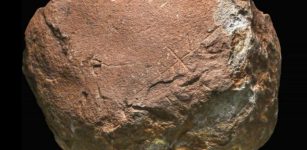 200,000-Year-Old Stone Engravings Found In Marbella Could Rewrite The History Of Prehistoric Art
Archaeology | Mar 17, 2025
200,000-Year-Old Stone Engravings Found In Marbella Could Rewrite The History Of Prehistoric Art
Archaeology | Mar 17, 2025 -
 Aboriginal Creation Story Of Marala Was True – World’s Largest Dinosaur Footprints Confirm Ancient Creation Myth
Archaeology | Mar 29, 2017
Aboriginal Creation Story Of Marala Was True – World’s Largest Dinosaur Footprints Confirm Ancient Creation Myth
Archaeology | Mar 29, 2017 -
 Birth Of Good And Evil In Iroquois Beliefs
Featured Stories | Sep 23, 2019
Birth Of Good And Evil In Iroquois Beliefs
Featured Stories | Sep 23, 2019 -
 Easter Island May Offer Proof Of An Alien Apocalypse
Archaeology | Jun 7, 2018
Easter Island May Offer Proof Of An Alien Apocalypse
Archaeology | Jun 7, 2018

